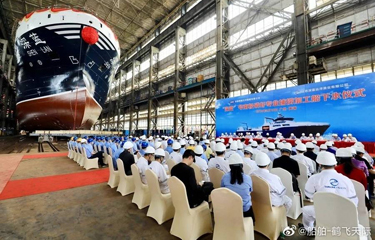China's “most modern” processing ship makes maiden voyage

What’s being billed as the most modern fishing and processing vessel in the world has departed from a Chinese port for a “trial voyage” to the Southern Ocean.
A subsidiary of Chinese marine engineering firm Shanghai Chong He Industry Group (also known as Chong He Marine Heavy Industries Co) – which specializes in “niche” marine equipment such as underwater mining and wind power installation facilities – has launched what it claims is the world’s largest purpose-built vessel for fishing Antarctic krill. The ship was designed by Wärtsilä Ship Design Company, which in March was commissioned to design a second –even bigger – krill processing vessel for Chong He Marine.
At 120 meters in length and 21 meters in width, the “Shen Lan” was launched from a port in Shanghai by Chong He subsidiary Jiangsu Shen Lan Distant Water Fishing Co. (also known as Jiangsu Sunline Deep Sea Fishery Co. or Sunline Fishery). The firm aims to increase its krill processing with the new vessel with the goal of producing human health products such as “blood fat thinning” products, as well as aquafeed.
Among the suppliers of equipment for the new, fully-automated processing vessel were Swedish-Swiss electrical engineering firm ABB, whose logo is visible on equipment photographed by the ship’s owners for promotional material. In a visit to Norway in 2018 with a delegation led by Jiangsu provincial governor, Sunline CEO Wang Zhi signed a cooperative agreement with Wärtsilä Ship Design Company and, in a presentation to a Norwegian audience, he declared his company’s ambition to become a “leading force” in the Chinese fishery industry.
Chinese fishing firms have in recent years targeted Antarctic krill (Euphausia superba), with local and national government support. The Chinese government has also enthusiastically encouraged the development of the domestic krill processing industry. Among those attending the initial commissioning of the “Shen Lan” (the name translates as “Deep Blue”) a year ago was Yu Kangzhen, vice minister at China’s Agricultural Ministry, which also overseas regulation of China’s fisheries sector.
Antarctic krill biomass for the Southern Ocean is managed under the Convention for the Conservation of Antarctic Marine Living Resources (CCAMLR), with current limits set at 3.75 million tons. Last year, China and the European Union inked a marine cooperation agreement that will see them working to protect Antarctic ecosystems.
Krill oil, rich in heart-healthy omega-3 fatty acids, is a popular nutritional supplement, but a recent report from Greenpeace claims growing demand (krill has also become a popular input for pet, livestock, and aquaculture feed) is fueling commercial fishing in Antarctica, which is in turn endangering polar wildlife, including penguins, which depend on krill for their survival.
Photo courtesy of Jiangsu Shen Lan Distant Water Fishing Co.






Share